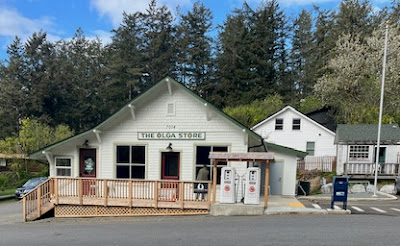About Us

- Saltwater People Historical Society
- San Juan Archipelago, Washington State, United States
- A society formed in 2009 for the purpose of collecting, preserving, celebrating, and disseminating the maritime history of the San Juan Islands and northern Puget Sound area. Check this log for tales from out-of-print publications as well as from members and friends. There are circa 750, often long entries, on a broad range of maritime topics; there are search aids at the bottom of the log. Please ask for permission to use any photo posted on this site. Thank you.
28 April 2024
21 April 2024
BOOK REVIEW: The SINKING OF THE PRINCESS SOPHIA . . .
 |
PRINCESS SOPHIA Last position Vanderbilt Reef, Lynn Canal, Alaska 24 October 1918 All hands lost. Photograph by Winter-Pond Co. Juneau, AK. |
Authors Ken Coates and Bill Morrison
Oxford University Press,
Don Mills, Ontario, Canada.
 |
PRINCESS SOPHIA photo dated 24 October 1918. Vanderbilt Reef, Alaska. Orginal photo from the archives of the Saltwater People Historical Society |
12 April 2024
THE "FRENCHMAN"
Captain Orison Beaton was born in the lumber town of Port Madison 30 August 1878, one of five children. He ran away from home at the age of fifteen and the world unfolded to him from the decks of Puget Sound steamers. Later, applying for his first job on a tugboat, he was asked his name. "That's too long and doesn't suit a seafaring man," said the skipper. I'll call you Jim." Young Jim worked up to become master of several of the Puget Sound Tugboat Co.'s tugs; it was during this time he also earned himself a reputation as a good marine photographer.
Perhaps his best-known photograph is that of the three-masted French bark COLONEL De VILLEBOIS MAREUIL passing in over the Columbia River Bar in tow of the tugs GOLIAH and TATOOSH in October 1912. Horace McCurdy recounts the experience as told him by Capt. Beaton:" I saw this enormous sea rolling up astern," said the captain, "and from the tug it appeared as if the bark was being engulfed. My camera was ready and I ducked hurriedly out of the pilot house door, snapped the picture and got back inside just as the GOLIAH herself was smothered in foam. Light conditions were very poor and it was necessary to develop the negative an extra long time to bring up an image."
Captain Beaton was the co-author of what has now become known as the Plummer-Beaton collection of marine photographs. He passed away 29 August 1938.
Short Biographies of Photographers Who Helped to Record the Maritime History of the Pacific Northwest.By Gordon P. Jones
Puget Sound Maritime Historial Association Newsletter Supplement.
November 1966.
From the Library of the Saltwater People Historial Society.
05 April 2024
SEATTLE'S BARKENTINE DAYS
jpg.jpg) |
Barkentine DIAMOND HEAD (ex-Gainsborough) O.N. 157574 194.2' x 31.2' x 20.2' G.t. 1,012 Built 1866 photo by the remarkable tug master Capt. H.H. Morrison Undated. Low-res in public domain. |
Text by Margaret Pitcairn Strachan
Courtesy of the Seattle Times 1947
"In 1866 an English ship-building firm named C. Longley christened the first large iron-hulled ship. Hundreds of persons flooded to watch her make her way into the Thames, expecting to see her sink, because such a novelty as a barkentine made of iron couldn't float! But cheers soon were forthcoming, and all those folk who saw the wonder of that age, sail proudly forth, are dead, while today (1947) the ship herself carries on in Seattle's own Lake Union.
The Lady Gainsborough was indeed a thing of beauty. Painted white, with trimmings of mahogany and with solid teakwood railings, the barkentine had three tremendous masts that carried heavy canvas.
Today, denuded of masts and super-structure and old-time fittings, she goes by the name of Diamond Head and is leased by the General Petroleum Co to Seattle's City Light for use as an oil-storage tank. Next year, when modern facilities replace the Diamond Head, she will revert to her previous job as an oil barge.
Fantastic tales have been written about the ship, but mostly they have been the product of someone's imagination. Her real story is thrilling enough without resorting to invention.
The Lady Gainsborough broke all records when she was in her prime, sailing around Cape Horn with her canvas whipping in the wind. She took mail to Englishmen stationed at the outposts of the Empire, and carried distinguished European passengers. Sometimes she stopped at China and brought back Chinese coolies, crowded together in her hold.
When bigger ships were constructed, the Gainsborough became a tramp, carrying cargoes of coal and sugar. Laden with coal from Westport, N.Z., she was wrecked at Diamond Head, HI., 31 August 1896. Auctioned for $1,800 and pulled off, she was towed into port and placed under the Hawaiian flag. She was renamed the Diamond Head, for the place where she had come to grief. She served in Allen & Robinson's line of packets between Honolulu and West Coast ports of the US.
From this time on, the Pacific Northwest figured in the log of the ship. Under a Capt. Petersen, she sailed from Port Gamble, Port Blakely, Port Townsend, Seattle, Vancouver, WA., and Ladysmith, B.C.
There was a Captain who well remembers this phase of the ship's history, for he sailed on her as mate in 1907.
The former mate is Capt. Waldemar C. Sorensen of Woodinville. The other day he came to board the Diamond Head once more and stand beside her wheel while I plied him with questions aboard the ship.
"Here was where the first mate slept." he said, walking along the tarred deck "and here was the second mate's bunk, and here was the dining room. I first saw her when I was a deckboy, sailing on a Danish schooner in 1885. We were lying by Big Ben at London, and she came in. She was good-looking in those days, all right! All white-painted and with the figurehead of the Duchess of Gainsborough."
Capt. Sorensen enjoyed meeting the present watchman of the Diamond Head, who is in truth a watch-woman--Mrs. Philip Mettler. Mrs. Mettler's husband became the watchman in 1935 and they lived on board, occupying the captain's quarters for two years while a houseboat was prepared for them next to the ship. When there was talk of doing away with the ship, Mettler began working on barges for General Petroleum. Then came the shortage of oil during the war and once more the ship was needed. Mrs. Mettler obtained her license as a "qualified tanker man,"
Three years after Sorensen sailed on the Diamond Head she was sold to the Tyee Whaling Co of San Francisco. Under the command of Captain Barnason, for five years her decks rang with the shouts of whaling men. General Petroleum Co., next purchased the vessel and her glorious days of riding the waves were over.














